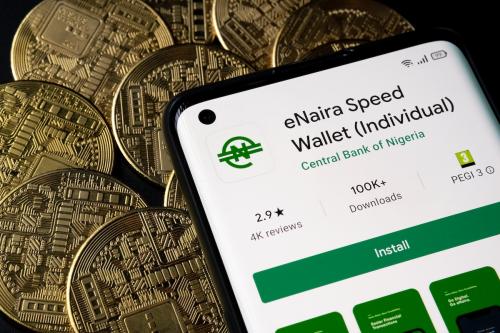This viewpoint is part of Foresight Africa 2024.
Technology is a word that describes something that doesn’t work yet.
Douglas Adams
As we enter 2024, the discourse on digital public services delivery (D-PSD) has garnered increased attention. Through the lens of D-PSD, I assess the dynamic interactions between the government and the market economy—its citizens, businesses, and civil society.
Public services delivery (PSD) reflects the intricate interactions between the public and private sectors. Digitalizing these interactions, aka D-PSD, means integrating digital technology to make them seamless, efficient, and transparent. Of course, D-PSD could raise other concerns regarding privacy and exclusion. Yet, it is no longer just an add-on; “digital” has become an integral fabric of our societal machinery, facilitating faster, more convenient interactions, eliminating systemic frictions, enforcing compliance, and addressing coordination failures.
In Ghana, there is a distinct vision for broader digital services, exemplified by its Digital Agenda, Digital Financial Services Policy, and other significant initiatives, which I will attempt to emphasize. That said, the government’s one-sided digital thrust is keen and fast on revenue collection but slow in reciprocating payments, particularly to businesses. This unwelcome feature illustrates a double standard in D-PSD and is in sharp contrast to the golden rule—“Do unto others as you would have them do unto you.”1 As I reflect on Ghana’s digital journey thus far and gaze into the horizon of 2024, three focal areas in D-PSD demand rigorous scrutiny: government-to-persons (G2P), government-to-businesses (G2B), and conversely, persons or businesses to government (P/B2G) services.
Government-to-persons (G2P): G2P interactions are pivotal for government’s engagement with citizens. Digital cash transfers, exemplified by platforms like e-zwich (2008), are hailed for potential poverty alleviation but grapple with targeting and delivery challenges. PREMIX fuel distribution (2023), a crucial lifeline for the local fishing communities, faces black-market disruptions and distribution hurdles. Digital interventions, especially automation and biometric systems, could streamline this. Conversely, the government’s partnership with Zipline in 2019 to leverage drone technology for prompt delivery of medical services showcases the broader potential of digital innovation in public services. Tapping into digital verification to curtail “ghost names” on government payrolls is another integration, and the list goes on and on.
Government-to-businesses (G2B): G2B digital interactions reveal an unsettling paradox. Despite G2B’s critical role, its digital footprint is surprisingly limited, a gap evident in Ghana’s vision for broader digital services. While digitization could overhaul bureaucratic snags, many (potentially high-quality) firms avoid government contracts, daunted by administrative hurdles and payment delays. Unfortunately, the government’s digital thrust seems one-sided, keen on digital revenue collection but sluggish in reciprocating. Introducing the Smart Workplace Virtual Platform (2020) emphasizes government-to-government interfaces more than G2B, and the tepid response from ministries exacerbates concerns. Conversely, the directive to use Government Integrated Financial Management Information System (GIFMIS) for Public Procurement Authority (2020) payments is a step forward but does not address the broader G2B integration issues.
A shift toward comprehensive government-to-businesses integration is crucial for productive and equitable digital service delivery.
Persons or businesses to government (P/B2G): The interactions between persons and businesses to the government, particularly in taxation, bill payments, and registrations, present a vivid illustration of our digital (r)evolution and challenges. At the forefront of this revolution is the historic rollout of the Unified Digital Property Tax Platform (2023). This initiative epitomizes the fervor for revenue mobilization and the expansion of the tax bracket.
We observe a troubling trend as we evaluate centralized payment platforms such as GIFMIS, GhanaPay (2022), and GHANA.GOV. There is an undeniable inertia in integrating G2B services. Many firms express reluctance to engage with government business, particularly procurement contracts, owing to the prevailing bureaucratic hurdles. The low uptake, especially concerning digital revenue mobilization platforms, suggests looming resistance from Metropolitan, Municipal, and District Assemblies (MMDAs) and bureaucrats. The scourge of corruption, infrastructural deficiencies like limited internet access, and digital literacy gaps further limit the adoption and value of D-PSD.
If the current adoption and usage patterns persist, we risk creating an uneven, exclusionary digital public services landscape. Such a trajectory could culminate in a “D-PSD divide,” sidelining certain businesses and citizens from arguably transparent and efficient public services. Central to the advancements in D-PSD is the establishment of robust identification mechanisms and business formalizations. Although there is momentum with government mandates on ID laws, concerns remain, especially around the perceived costs of formalizing businesses and the potential exclusion from digital systems. Undoubtedly, the current G2B digital landscape leans away from its potential. Therefore, a shift toward comprehensive G2B integration is crucial for productive and equitable digital service delivery.
-
Footnotes
- (Matthew 7:12).





Commentary
Digital public services delivery in Ghana
July 31, 2024